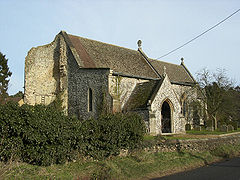Cockley Cley
| Cockley Cley | |
|---|---|
 All Saints Church | |
Location within Norfolk | |
| Area | 17.94 km2 (6.93 sq mi) |
| Population | 232 (2011)[1] |
| • Density | 13/km2 (34/sq mi) |
| OS grid reference | TF792042 |
| Civil parish |
|
| District | |
| Shire county | |
| Region | |
| Country | England |
| Sovereign state | United Kingdom |
| Post town | SWAFFHAM |
| Postcode district | PE37 |
| Dialling code | 01760 |
| Police | Norfolk |
| Fire | Norfolk |
| Ambulance | East of England |
Cockley Cley is a village and civil parish in the English county of Norfolk. The village covers an area of 17.94 km2 (6.93 sq mi) and falls within the district of Breckland.
History
[edit]The village's name is of Anglo-Saxon origin and derives from the Old English for a "clay hill shrouded in trees".[2]
In the Domesday Book, Cockley Cley is recorded as a settlement of 32 households located in the hundred of South Greenhoe. In 1086, the village was divided between the estates of King William I and William de Warenne.[3]
Cockley Cley is the site of significant defensive infrastructure built during the Second World War, including a rare example of an "Allan Williams Turret" designed to mount a Lewis gun in an anti-aircraft role.[4]
In August 1974, a decapitated corpse of a woman was discovered near the village. As of 2023, the woman has not been identified.[citation needed]
Between 1975 and 2004, Cockley Cley was home to a mock Iceni village visitor attraction. The site reopened briefly in 2014 as the Iceni Centre but was subsequently forced to close due to dwindling customer numbers.[5]
Geography
[edit]In the 2011 census, Cockley Cley was recorded as having 232 residents living in 117 households.[6]
The village falls within the constituency of Mid Norfolk and is represented at Parliament by George Freeman MP of the Conservative Party.
All Saints' Church
[edit]Cockley Cley's parish church is one of Norfolk's 124 existing Anglo-Saxon round-tower churches. The church was significantly remodelled in the nineteenth century by the architect Richard Phipson. The church tower collapsed on 29 August 1991 and has not been rebuilt.[7]
War memorial
[edit]Cockley Cley's war memorial is a marble plaque located inside All Saints' Church which lists the following names for the First World War:
- Corporal William B. Root (1893–1916), 8th Battalion, Royal Norfolk Regiment
- Corporal Frederick Atter (1896–1917), 9th Battalion, Royal Norfolk Regiment
- Lance-Corporal Wallace G. Rungary (d.1918), 1st Battalion, Royal Norfolk Regiment
- Fireman Frederick W. Barker (1887–1915), S.S. Sailor Prince
- Private Henry Norman (1885–1916), 14th Battalion, Gloucestershire Regiment
- Private Charles R. Wilding (1883–1915), 8th Battalion, Royal Norfolk Regiment
- F. Draper
- E. Pedgrift
The following were added following the Second World War:
- Marine Sydney A. Holman (1924–1944), H.M. Landing Craft (Flack) 14
- Private Russell K. Pigg (1917–1940), 2nd Battalion, Royal Norfolk Regiment
Gallery
[edit]- Cockley Cley village sign, showing the church still with its tower
- Rare Allan Williams Turret fortifications of World War II in Cockley Cley
- Entrance to the reconstruction of an Iceni village, now closed
References
[edit]- ^ "Civil Parish population 2011". Neighbourhood Statistics. Office for National Statistics. Retrieved 1 August 2016.
- ^ "Key to English Place-names". kepn.nottingham.ac.uk. Retrieved 16 October 2024.
- ^ "[Cockley] Cley | Domesday Book". opendomesday.org. Retrieved 16 October 2024.
- ^ "World-War-Two-Allan-Williams-Turret - Norfolk Heritage Explorer". www.heritage.norfolk.gov.uk. Retrieved 16 October 2024.
- ^ "Iceni Centre, formerly the Iceni Village, closes despite attempted revival". Eastern Daily Press. 15 July 2014. Retrieved 16 October 2024.
- ^ "Custom report - Nomis - Official Census and Labour Market Statistics". www.nomisweb.co.uk. Retrieved 16 October 2024.
- ^ "Norfolk Churches". www.norfolkchurches.co.uk. Retrieved 16 October 2024.
http://kepn.nottingham.ac.uk/map/place/Norfolk/Cockley%20Clay
External links
[edit]


 French
French Deutsch
Deutsch


